 |
|||
Paul Gillon Der französische Autor und Zeichner wurde am 11. Mai 1926 in Paris geboren. Sein außergewöhnliches Talent brachte ihn im Laufe seiner langen Karriere in fast alle bekannten französischen Comic-Magazine und -Verlage; wie zum Beispiel dem Journal de Mickey, Vaillant, France Soir oder dem Métal Hurlant (dt. Schwermetal). In jungen Jahren wurde Paul Gillon sehr krank (Knochen-Tuberkulose) und verbrachte seine frühe Kindheit immer wieder in verschiedenen Kliniken und Hospitälern. Ohne die rechte Chance auf eine "normale Kindheit", verwandelte sich sein Zorn und seine Frustration über die Krankheit in Wut und Auflehnung. Dieses rebellische Verhalten half ihm jedoch nicht gerade in seiner schulischen Ausbildung und so wurde der junge Gillon wegen seines Aufbegehren gegen Obrigkeiten letztlich aus fast jeder Schule geworfen. Doch eine Leidenschaft hatte der junge Gillon: das Zeichnen! Bereits im Alter von 14 Jahren - während des Krieges - zeichnete er Karikaturen und Illustrationen für lokale Zeitungen, wie dem Samedi-Soir, France Dimanche, Gavroche und Fillette. Für verschiedene Verleger gestaltete Gillon zudem unzählige Buchtitel. Nach einigen Umwegen schaffte er endlich den Sprung auf eine Grafikschule; der "l’École des Arts Graphiques" Schule in Paris. 1947 ging Gillon zum damals führenden französischen Comic-Magazin Vaillant und konnte dort an der Serie Lynx blanc - angelehnt an den bekannten Comic von Alex Raymond "Jungle Jim" - arbeiten (bis 1950). Autor war dabei einer der führenden Szenaristen von Vaillant Roger Lécureux. Mit ihm gestaltete Gillon auch die Geschichten über die Fils de Chine. (1950 bis 1953; 1978 bei Glénat als Sammelband erschienen) Für Szenarist Jean Ollivier - ebenfalls eine feste Größe bei Vaillant seit dem Start des Magazins im Jahr 1945 - zeichnete Gillon an der Serie Le Cormoran (1954). Auch dem "Vaillant"-Nachfolger "Pif Gadget" blieb Gillon treu und veröffentlichte dort unter anderem Ende der 1960er Jahre die Abenteuerserie "Jérémie" (deutsch bei Moewig erschienen). Über die Zeitspanne von 1959 bis 1972 zeichnete er für das Blatt "France Soir" über 4000 Strips des Zeitungscomics "13, rue de l'Espoir"; ersonnen von Jacques and Francois Gall. Für immer in die Comic-Historie eingeschrieben hat sich Paul Gillon aber mit dem Science-Fiction-Epos Les Naufragés du Temps (dt. "Die Schiffbrüchigen der Zeit", erschienen bei Bastei (nur gekürzt) und Carlsen), das er für Jean-Claude Forest' Magazin Chouchou nach dessen Texten zeichnete. Nach der Veröffentlichung der ersten neun Seiten (1964) war allerdings erstmal Schluß. Als er die Serie Mitte der 1970er Jahre für France Soir (1974 bis 1975) und Métal Hurlant (1977 bis 1989) wieder aufleben ließ, übernahm Gillon ab Band 5 und dem Wechsel zu Métal Hurlant das Schreiben der Szenarios. Nicht zuletzt für die Arbeit an diesem großen Klassiker der Comic-Literatur wurde Paul Gillon mit dem Grand Prix d'Angoulême 1982 ausgezeichnet. Gillon´s meisterlicher realistischer Zeichenstil ist zeitlos, elegant, präzise und von hoher anatomischer Fertigkeit - ähnlich den Stilen von Künstlern wie Alex Raymond oder Harold Foster. Zwischen 1985 und 1991 entstand für die Kollektion L'Écho des Savanes (Albin Michel) die erotische Science-Fiction Geschichte La Survivante, die Gillon, angeregt durch eine Idee von Claude Maggiori, selbst schrieb und gestaltete. Die vierbändige Erzählung nimmt Anleihen aus Richard Matheson's Roman "Ich bin Legende". Eine "Integrale Zusammenfassung" erschien erstmals 1995 ebenfalls bei Albin Michel. Das Label Drugstore legte 2011 erneut ein Integral-Album in Frankreich auf. Die Überlebende spielt in einer postapokalyptischen Welt. Der erste Band wirft den Leser ohne einleitende Erklärungen in die Handlung. Die junge Aude Albrespy taucht, nachdem sie tagelang in einer unterirdischen Höhle gefangen war, endlich wieder auf und stellt zu ihrem entsetzen fest, das ihre Freunde regelrecht verdampft sind. Bestätigt durch ihre ersten Eindrücke bei ihrer Fahrt zurück nach Paris, vermutet sie einen verheerenden Atomschlag, der sie zur "einzigen" Überlebenden von Europa macht. Einzig unzählige automatische Roboter sorgen in Abwesenheit jedweder Menschen für das aufrechterhalten der allgemeinen Versorgung und Ordnung in den Städten. Aude auf sich allein gestellt - verängstigt, voller Wut und Niedergeschlagenheit, - stromert durch das unzerstörte Paris, quatiert sich im besten Hotel ein und lässt es ich zunächst recht gut gehen. Ulysses, der Roboter-Butler des Crillon-Hotels erfüllt der einsamen Frau all ihre Wünsche. Unverhofft findet nach einigen Wochen ein weiterer Überlebender zu Aude: ein Mann. Voller Freude genießen "Adam-und-Eva"-gleich die beiden Überlebenden ihre Zeit miteinander; sehr zum Leidwesen des blechernen Dieners. Am Ende des ersten Bandes tötet Ulysses seinen "Nebenbuhler" und Aude schreit verzweifelt ihren Schmerz in die Nacht. Doch das kurze Liebesglück zwischen Aude und dem Mann blieb nicht ohne Folgen. Gleich zu Beginn des zweiten Bandes entbindet Ulysses Audes Baby und die junge Mutter sieht sich nun im emotionalen, zwiespältigen Kampf zwischen Ulysses und der einsamen, feindlichen Welt außerhalb ihrer Zuflucht. Einerseits voller Sehnsucht nach Liebe und Geborgenheit wirft sie sich dem Mörder des Kindsvaters in die Arme und andererseits kann sie sich - als eine Art Gefangene - von Ulysses nicht befreien. In den folgenden Seiten sieht man den jungen Jonas heranwachsen, um später - als Teenager - in den Kampf zwischen seiner Mutter und Ulysses einzugreifen. Ihr gemeinsamer Weg (Band 3) führt sie auf eine Raumstation, wo weitere Überlebende der Katastrophe warten. Wie auch in seiner Serie "Die Schiffbrüchigen der Zeit" ist Gillon um die ein oder andere Nacktszene nicht verlegen. In "Die Überlebende" geht jedoch das Gezeigte einen Schritt weiter in Richtung Erotik-Comic ohne je in wirklichen "Hardcore" zu wechseln. Die vier Bände "La Survivante" bieten eine packende, emotionale Erzählung, der man die vereinzelt vorkommenden platten Dialoge oder Szenen verzeiht. Die erotischen Elemente wurden "großzügig" in die Handlung eingebaut und sind zum Teil durchaus eindeutig und pornografisch. Ähnlich den Werken von Serpieri wollte Gillon dem Leser eine durch und durch erwachsene und ehrliche Geschichte bieten. Mit durchaus deutlichen Bildern. Ein weiteres Werk das ebenfalls mit einer spannenden - wenn auch historisch bekannten - Geschichte aufwartet und zugleich erotische Szenen bietet, ist die Comic-Umsetzung um Jeanne d’Arc, der Jungfrau von Orléans: Jehanne. Die zweibändige Geschichte erschien bei Albin Michel in den Jahren 1993 und 1997. Paul Gillon hat in einigen seiner erotischen Projekte - wie "La Survivante", "Jehanne" oder "Le Contrat" bewiesen, das man intelligente und spannende Geschichten mit einer anregenden Portion Sex kombinieren kann, ohne dabei Niveau und Stil zu verlieren. Paul Gillon verstarb am 21. Mai 2011 in Paris. Mit ihm verlor die "bande dessinèe"-Welt einen seiner besten Comiczeichner. Links: deutsche Veröffentlichung Alpha Comic Verlag (zwischen 1986 und 1998): französische Veröffentlichung/french publications: weitere Veröffentlichungen von Gillon (Auswahl/Selection): Dank an die Quellen von ActuaBD, BDZoom, Sex im Comic (A. Knigge) |
This translation is unedited!
Paul Gillon
The French author and artist was born on 11. May 1926 in Paris. His extraordinary talent has brought him to almost all the well-known French comic magazines and publishers throughout his long career, such as the Journal de Mickey, Vaillant, France Soir and Métal Hurlant.
At a young age, Paul Gillon became very ill (bone tuberculosis) and spent his early childhood in various clinics and hospitals. Without the right chance of a "normal childhood", his anger and frustration with the disease turned into anger and rebellion. This rebellious behaviour did not exactly help him in his school education and so the young Gillon was thrown out of almost every school because of his rebellion against authorities.
But the young Gillon had one passion: drawing! At the age of 14 - during the war - he already drew caricatures and illustrations for local newspapers such as Samedi-Soir, France Dimanche, Gavroche and Fillette. Gillon also designed countless book titles for various publishers.
After some detours, he finally managed to get into a graphic arts school; the "l' École des Arts Graphiques" school in Paris. After the orders got a bit thinner after the war, he followed a friend's advice to try out comics. He remembered the old classics of his childhood that he had read in the hospital; Flash Gordon, Terry & the Pirates or Prince Vailant.
In 1947, Gillon went to the then leading French comic magazine Vaillant and was able to work on the series Lynx blanc, based on the famous comic strip by Alex Raymond "Jungle Jim" (until 1950). Author was one of the leading scriptwriters of Vaillant Roger Lécureux. With him, Gillon also designed the stories about the Fils de Chine. For the writer Jean Ollivier - also a constant at Vaillant since the magazine was launched in 1945 - Gillon drew on the series Le Cormoran (1954).
Gillon also remained true to the "Vaillant" successor "Pif Gadget" and published the adventure series "Jérémie" (published in German by Moewig) at the end of the 1960s.
From 1959 to 1972, he drew more than 4000 strips of the newspaper comic "13, rue de l' Espoir" for the "France Soir", conceived by Jacques and Francois Gall.
However, Paul Gillon has forever inscribed himself in the history of comics with the science fiction epic Les Naufragés du Temps (The Shipwrecked of Time, published by Bastei (shortened only) and Carlsen), which he drew for Jean-Claude Forest's magazine Chouchou after his texts. After the publication of the first nine pages (1964) it was over for the time being. When he revived the series in the mid-1970s for France Soir (1974 to 1975) and Métal Hurlant (1977 to 1989), Gillon began writing the scenarios from Volume 5 onwards and switched to Métal Hurlant. Paul Gillon was awarded the 1982 Grand Prix d' Angoulême for his work on this great classic comic book.
Gillon's masterly realistic drawing style is timeless, elegant, precise and of high anatomical skill - similar to the styles of artists like Alex Raymond or Harold Foster.
Between 1985 and 1991, the erotic science fiction story La Survivante was created for the collection L' Écho des Savanes (Albin Michel), which Gillon, inspired by an idea by Claude Maggiori, wrote and designed herself. The four-volume story takes its inspiration from Richard Matheson's novel "Ich bin Legende". An "Integral Summary" was first published in 1995 by Albin Michel. The label Drugstore released another Integral album in France in 2011.
The survivor is playing in a post-apocalyptic world. The first volume throws the reader into the plot without introductory explanations. Young Aude Albrespy finally reappears after having been trapped for days in an underground cave and, to her horror, finds out that her friends have literally evaporated. Confirmed by her first impressions of her journey back to Paris, she suspects a devastating nuclear strike that makes her the "only" survivor of Europe.
Only countless automatic robots in the absence of any human beings ensure the maintenance of the general supply and order in the cities. Aude is on her own - frightened, angry and dejected - she streams through the undamaged Paris, quotes herself in the best hotel and lets me go quite well at first.
Ulysses, the robot butler of the Crillon Hotel, fulfils all her wishes for the lonely woman. Unexpectedly, after a few weeks, another survivor finds Aude: a man. Full of joy,"Adam and Eve"-like the two survivors, enjoy their time together; much to the chagrin of the tin servant. At the end of the first volume, Ulysses kills his "rival" and Aude screams desperately her pain into the night.
But the short happiness of love between Aude and the man was not without consequences. Right at the beginning of the second volume, Ulysses gives birth to Audes' baby and the young mother sees herself in the emotional, ambivalent struggle between Ulysses and the lonely, hostile world outside of her refuge. On the one hand, full of longing for love and security, she throws herself into the arms of the murderer of the child's father and on the other hand, as a kind of prisoner, she cannot free herself from Ulysses.
In the following pages you can see Jonas growing up and later on - as a teenager - intervening in the fight between his mother and Ulysses. Their common path (volume 3) leads them to a space station, where further survivors of the catastrophe are waiting for them. But the collective return to earth does not bring salvation for the remaining survivors. ...
As in his series "Die Schiffbrüchigen der Zeit", Gillon is not embarrassed by the nude scene. In" The Survivors", however, what is shown goes a step further in the direction of erotic comic without ever switching to real "hardcore".
The four volumes "La Survivante" offer a gripping, emotional narrative that forgives the isolated, flat dialogues or scenes. The erotic elements have been "generously" integrated into the plot and are partly quite clear and pornographic. Similar to Serpieri's works, Gillon wanted to offer the reader a thoroughly mature and honest story. With quite explicit pictures.
Another work that also boasts an exciting - albeit historically well-known - story and at the same time offers erotic scenes is the comic-book adaptation of Jeanne d' Arc, the Virgin of Orleans: Jehanne. The two-volume story was published by Albin Michel in 1993 and 1997. The opening page of the first volume, in which Gillon drew the young Jeanne d´Arc lying asleep in the grass, drew a little bit of trouble as she let a sheep "spoil" her. Some foreign publications simply left out this suggestive but harmless side.
Paul Gillon has proven in some of his erotic projects - such as "La Survivante","Jehanne" or "Le Contrat" - that intelligent and exciting stories can be combined with a stimulating portion of sex without losing level and style.
Paul Gillon died on 21 May 2011 in Paris. With him, the "bande dessinèe"world lost one of his best comic-strip artists. |
||||||||
 |
|||||||||
 |
|||||||||
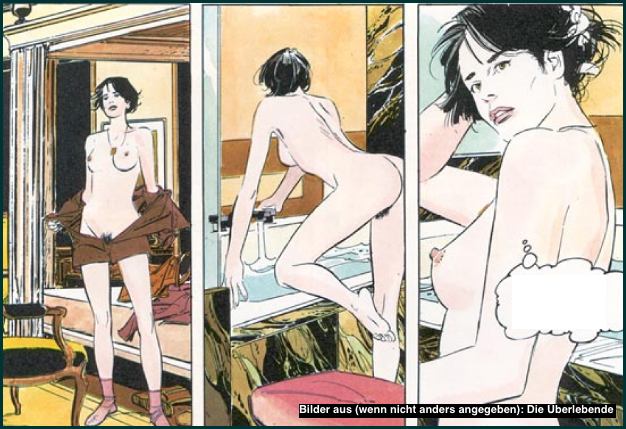 |
|||||||||
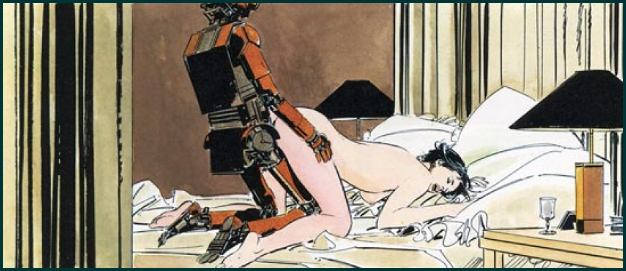 |
||
 |
||
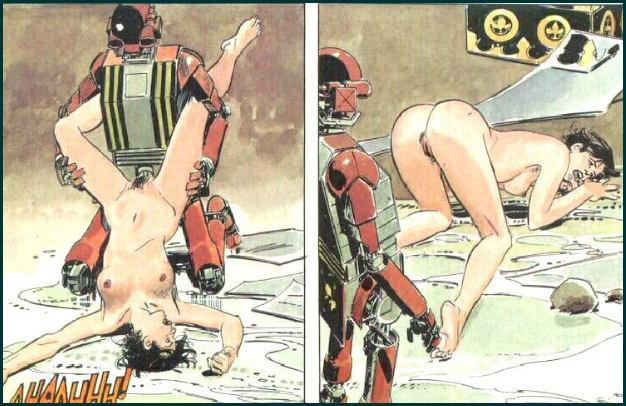 |
||
 |
||
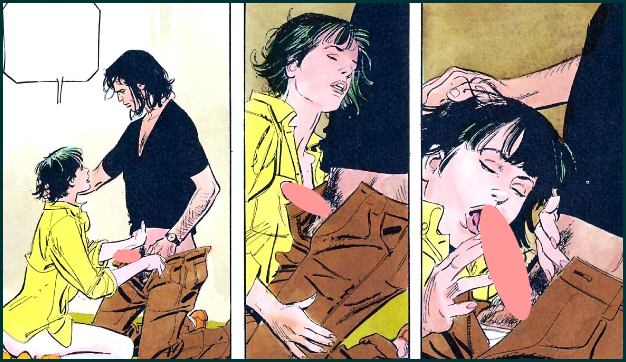 |
||
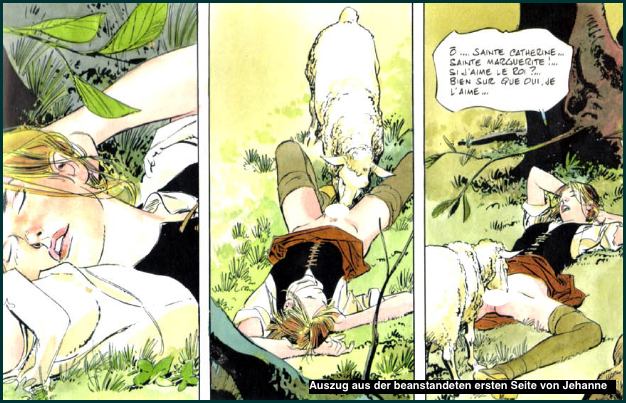 |
||
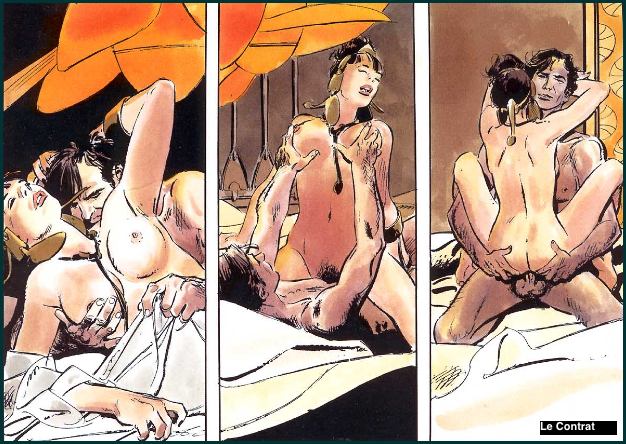 |
||